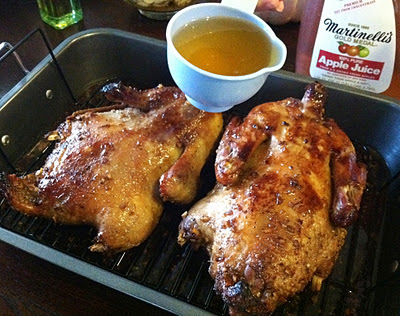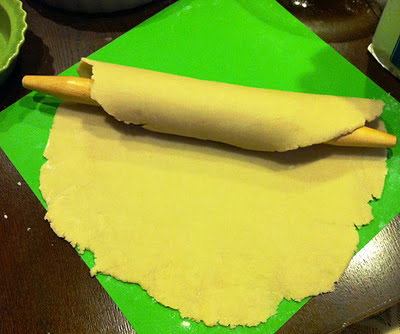I hope everyone had a food-filling wonderful Thanksgiving. My family's Thanksgiving was stuffed with lots of laughter and love from our family and friends.
If you have been following my facebook page, you would've seen what I had prepped and planned for the Thanksgiving feast. I had prepared ingredients for 15 dishes but was only able to get 14 dishes on the table by the next morning. Not too bad I supposed.
 |
| steamed black rice with preserved duck eggs, diced carrots and chinese sausage |
 |
| Roasted Ducks |
We had lots of main dishes, appetizers and side dishes but there was a shortage of desserts. Thanks to my sister-in-law who brought over a couple of homemade taro pies. Everyone was eager to try it out as we haven't had taro pie in our lives ever. It was simply delicious! Though I'm usually not much of a sweet tooth and don't care much for desserts, I must say I thoroughly enjoyed the taro pie. I always love to study and work with these ingredients that are representative of Southeast Asia and taro is definitely one of my favorite.
I got the recipe from my sister-in-law and adjusted the recipe a little bit to my taste. Since then, I've been hit with baking fever and have been making taro pies 2-3 times a week!
My sister-in-law used store-bought pie shells as it saves half the time but I prefer to make it from scratch. Pie shells can be bought at any American grocery stores and they are inexpensive (about $3 per package for 2 shells). Taro root can be found at most Asian supermarkets. I love the nice starchy, sweet, and mild flavor of the purplish taro and even more so when it's surrounded by a deliciously rich and buttery flavored pie crusting. This would make a nice dessert to pair with hot green tea or coffee to go with the holiday spirit.
* * *
*
RECIPE: Bánh Khoai Môn Pie (Taro Pie)
Ingredients
For Taro Filling
2 pounds of Taro roots
3 Eggs
1 1/2 cups Sugar
4 tablespoons All-Purpose Flour
2 cups Whole Milk
1 teaspoon Pure Vanilla Extract
For Pie Shells (make two 9-inch pie shells)
2 1/2 cups All-Purpose Flour
1/2 teaspoon Salt
3 tablespoons Sugar
1/4 cup Vegetable Shortening, cold
1 1/2 stick Unsalted Butter (12 tablespoons), cubed and cold
2/3 cup Iced Water
*
Making Pie Shells
In a large mixing bowl or a clean surface, mix flour, sugar and salt well.
Add the shortening and break it up with your hands as you start to coat it up with the flour.
Add the cold butter cubes and work it into the flour with your hands quickly, so the butter doesn't get too soft, until the mixture is crumbly.
Add the shortening and break it up with your hands as you start to coat it up with the flour.
Add the cold butter cubes and work it into the flour with your hands quickly, so the butter doesn't get too soft, until the mixture is crumbly.
Sprinkle in water, a little at a time and mix it with your hands until the mixture comes together forming a dough. Pack the dough together into a ball.
Divide the dough in half and flatten it slightly to form a disk shape. Wrap each disk in plastic wrap and chill in the refrigerator for about 30 minutes before rolling out.
Unbaked pie dough can be kept in the refrigerator, tightly wrap with plastic wrap and foil, for about 4 days. Let it soften a bit at room temperature before you roll it out. It can also be frozen for at least 3 months.
Unbaked pie dough can be kept in the refrigerator, tightly wrap with plastic wrap and foil, for about 4 days. Let it soften a bit at room temperature before you roll it out. It can also be frozen for at least 3 months.
*
Making Taro Filling
Cut taro into big chunks. In a pot, cover taro with just enough water and bring it to a boil. Reduce heat and cook for about 15-20 minutes or until the taro is cooked.
Discard the water and place taro in the food processor and puree until a fine paste is formed. Transfer taro into a mixing bowl.
Beat eggs lightly in a separate bowl. Combine eggs and the remaining taro filling ingredients in taro mixing bowl. Mix well and set aside.
*
Putting Taro Pie Together
Preheat to 350 degrees.
On a lightly floured surface, roll each disk out into an 11 or 12-inch circle, 1/8-inch-thick using a flour-dusted rolling pin; ultimately this is used to make a 9-inch pie.
Roll the dough onto a rolling pin to facilitate transferring into a 9-inch pie pan. Gently fit the pastry into the pan without stretching it; let it hang over the edge. Add taro filling.
Roll the dough onto a rolling pin to facilitate transferring into a 9-inch pie pan. Gently fit the pastry into the pan without stretching it; let it hang over the edge. Add taro filling.
Roll up the overhang and pinch the edge with your thumbs and index fingers into a fluted rim. Brush egg yolk over the fluted rim.
*
Baking Pie





















































